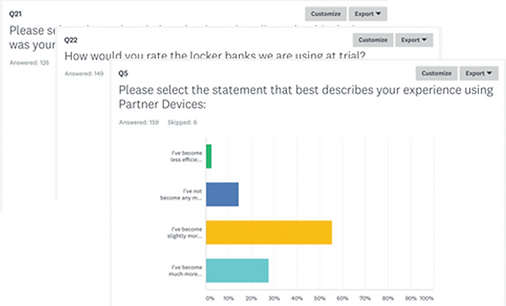
John Lewis & Partners
Partner App
My role
Lead UX & Service Research & Design
Overview
The brief for this project was to research and design a digital product for the retail staff or ‘Partners’ that work in the John Lewis stores across the UK. The business objectives were to increase the retail staff's productivity, efficiency, and happiness, amongst other KPIs by equipping them with a tool to better enable them in their roles.
UX research responsibilities
Qualitative research
Quantitive research
Survey design
Workshop facilitation
User testing planning
Ethnography
One on one interviews
Store visits
User journey empathy
UX design responsibilities
Sketching
Wireframing (Axure)
Prototyping
UI / development collaboration
Stakeholder communication
Service design
Research Phase
John Lewis provided the team and I with a brief that contained Key Performance Indicators (KPIs) that we needed to measure, to determine the success of the Partner App initiative. When I joined the project, an initial build of Partner App had been launched on trial in the Cambridge store, and my first task was to monitor the feedback data coming back from the Partners in relation to these KPIs. The ultimate goal was to contribute this KPI research data to a business plan, that was to be given to the board of Directors who would then determine if the Partner App was to be implemented in stores across the UK.

The Users
The users were the Sales Assistants that work in the John Lewis retail stores, and before I joined the project, workshops were run to determine the user types. The two persona types that came out of these workshops was the ‘Stare & Share’ persona, a user who is less mobile than the other persona and needs to perform tasks that would typically require a bigger screen. The second persona type was called ‘Scan & Scuttle’, these personas were much more mobile on the shop floor and spent less time serving customers.

Quantitive Survey Research
Using Survey Monkey, I created a series of questions designed to collate Partner feedback that we could use to determine the successes or shortcomings of the KPIs we were given. This research method proved highly effective at providing clarity to the business, and it enabled me to provide exact mathematical statistics that represented the end users feelings. It allowed my stakeholders to give tangible feedback to the board of Directors to inform their decision making on the rollout of Partner App nationwide.

Service Design
We experimented with different wearables for the Partners to carry the Partner Devices around with. We experimented with lanyards that they could wear around their necks with the devices attached. We received lots of negative feedback about these, Partners said that they were uncomfortable to wear around their necks and would swing when they had to bend down throughout the day. As a result, we provided them with device cases with a belt clip or a lanyard, which they could wear over one shoulder. These new wearables proved much more effective at maintaining the Partners' mobility and comfort around the store.

Trial Success & Go Live
After a successful trial period in the Cambridge store, the board decided to roll out Partner Devices to every store across the UK. This was a major achievement for the team and a testament to the positive impact the product had had in the trial store. The initial scope for Partner App was that it would be rolled out to every store across the UK over a number of years, but the decision was made to roll out to every store in one year so that every Partner could benefit from Partner App as soon as possible.

New Discovery UX Workshops
After the first launch of Partner App, John Lewis & Partners asked me to conduct a series of UX workshops with more senior Partners and management within the retail stores. The aim of these workshops was to discover these Partners' goals, needs, and pain points within their current roles and with the current technology they were provided.

Redesign & User Testing
The trial version of Partner App had been created using a version of the old customer app codebase, with some features stripped out and some tweaks made to modify it to work in a Partners' context. However, now the trial had been successful, John Lewis asked the team to create a second version of the design to optimize Partner App’s usability. We took the wealth of research and learnings we had collated during the trial phase and alongside analytics of the usage so far, we set about redesigning Partner App. I sketched concepts, created wireframes and built prototypes that we used to test and validate our thinking.

Conclusion
I worked on Partner App for 18 months, during which time I was responsible for research strategy & execution, conceptualization & design, user testing design and workshop creation & execution, alongside a whole host of other responsibilities.
This product has been a major user and business success for John Lewis and it’s Partners. In 2017 Partner App was commercially recognized by winning the Engage: Best Customer and Employee Engagement Award 2017.
Project outcomes
Engage Award Winner 2017
14,000 Users
Live In 49 UK Stores
130,000+ Products Sold
4 Million Product Searches

Explore More Projects





